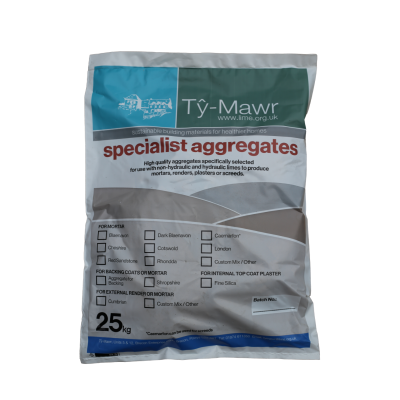Ty-Mawr Lime Putty
Collection
Next Day Pallet
Economy Pallet
Parcel Delivery
Limestone (Calcium Carbonate – CaCO3) is burnt in a kiln giving off Carbon Dioxide (CO2) gas and forming Calcium Oxide (CaO) which is commonly known as Quicklime or Lumplime. It needs to be burnt at 900-1100°C to ensure a good material is produced. The resulting lime is at its most volatile and dangerous at this stage.
Lime Slaking
The Burnt Lime or Quicklime is then combined with water (slaked) as quickly as possible. Combining Quicklime (CaO) and water (H20) produces Calcium Hydroxide (Ca(OH)2 - slaked lime and heat.* We combine it with an excess of water which produces a putty. It is also known as non-hydraulic lime because it requires exposure to air in order to carbonate and does not set under water.
Lime putty is suitable for:
i) Blending in the correct ratios with appropriate sands to produce plasters and mortars (coarse is ideal for this purpose).
ii) Diluting with water to produce limewash or lime water (fine is ideal for this purpose).
Premixed ‘wet’ products are made from lime putty with the addition of an aggregate and/or fibre to save you having to blend on site and include mortar, plaster, glaster and lime hemp plaster.
This lime is regarded as the most appropriate lime for old buildings where maximum permeability and flexibility is required especially suitable for pointing brick and soft stone work and is highly suitable for nearly all internal plastering and rendering onto cob, straw etc. See the Documentation section for application guides, coshh sheets and our winter weather warning.
Availability
Our lime putty is available in 20 litre buckets or 1 tonne bulk bags (please note if you require less than 6 tonne in bulk bags then we will probably need to ship this by pallet carriers, please note they will only accept lime putty in crates, you will therefore have to choose the 1 tonne bag in crates). For 6 tonne or above, we would try to deliver the bulk bags on our lorries to avoid the additional cost of the crates but the cost-effectiveness will depend on miles. If you add to your basket, we will save the order and get back to you with the most economic delivery.
Bulk order discounts apply to this product, the more you add the more discount you will accumulate!
Fat Lime Putty or Non-Hydraulic Lime is produced by slaking fresh Quicklime (Lump Lime) in an excess of water which is then left to mature.
Fat lime putty is also known as non-hydraulic lime as it requires exposure to air to carbonate and does not set under water. This lime is often regarded as the most appropriate lime to use for applications in the conservation of old buildings where maximum permeability is required.
Fat Lime Putty can be blended with sand to produce lime plasters and mortars or it can be diluted with water to produce limewash.
Suitable for
- Making your own mortars
- Making your own plasters
- Making your own limewash
Coverage
- One Bucket of putty will make two buckets of limewash
- It is regarded as the most appropriate lime to use in the conservation of old buildings where it is important to maximise softness, vapour permeability and flexibility.
- It keeps indefinetly and especially well in buckets when stored correctly.
- 20kg Bucket
- 1 Tonne Bulk Bag

















